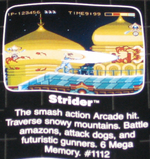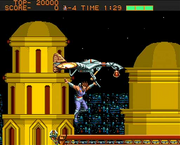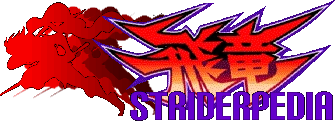
The Mega Drive port of Strider was the first official Japanese port of the Arcade game to home consoles, and the second overall after Tiertex' conversions for European home computers. The game was developed entirely in-house by Sega themselves, which is reflected on a second 1990 copyright mark on its title screen claiming it to be a "reprogrammed game" by Sega. Handling ports of third-party games for their own consoles was a common practice of Sega during the early 90's, and the "reprogrammed" label can be seen in games such as SNK's Art of Fighting or Capcom's own Forgotten Worlds and Ghouls 'n Ghosts. This is also shared by the Master System port of Strider, although the port was actually programmed by Tiertex.
Development History[]
Strider started development at some point in late 1989/early 1990, an unknown number of months after its final release date in September[1]. The initial project team only consisted of three people: planner "PALKO", designer Taro Shizuoka and programmer/project leader Keiichi Yamamoto[1]. Their first action was to acquire development materials and source disks from the Arcade staff at Capcom and start to analyze them. While Shizuoka and Yamamoto checked the original programmer's code, PALKO mapped out documents in advance, eventually running into a 40-pages long novel detailing the background of Strider. Calling Capcom over this, he was told this was background story, but since it doesn't figure in the game proper he was free to ignore it.[1]

An earlier promo, stating it as having 6 Mega memory
When first announced, Strider was established to be developed as a 6 Mega cartridge game[2]. Around August, however, the development staff revealed the game's capacity was increased to a 8 Mega cartridge, citing it as a necessary step to perfectly port the game for consumer use[3]. This made Strider the first released game on a 8 Mega cartridge, a fact used to market it in both printed ads[4] and commercials[5][6] as the "First and Only 8-Meg Game Ever".
The staff still ran into several troubles fitting the large maps and variety of enemies within memory's limitations. To work around this they broke down maps into several areas and had each area's sprite data overwrite the previous one as needed[1], an action which seemingly led to each stage suffering from loading times between areas. This, however, did not resolve the issue entirely, and they ran into problems all the way through development. The last area in the Amazon stage was particularly difficult, and they were forced to place bush sprites in front of the Brontosaurus in order to hide the fact its walking animation could not be implemented and the dinosaur is simply "sliding" forward as if it had wheels on its feet[1]. The missing Tyrannosaurus enemy and the Amazoness' removed leaf sprite are probably also caused by memory issues in this area.
The team decided to create an original brand new ending using a music theme created by Capcom's sound team Alph Lyla wa Lyla. Said ending was inspired by the ending from The Revenge of Shinobi, mostly because the planner who created the storyboard and the sprite artist worked on both games.[1]
The bug testing phase began after summer vacation[1], somewhere around July/August. This phase was particularly gruelling as recounted by PALKO, remembering that due to approaching deadlines and the large amount of bugs found and fixed they started to work non-stop almost daily, at times hesitating to even take 1 or 2 hours to sleep. Since the team lacked in staff members they also had to request testers from other teams, who constantly noted bugs or differences with the source game that were caused by the Mega Drive's specs.[1]
Promotion[]
Strider was first revealed in Japan around April/May 1990 through gaming magazine coverage, and was officially unveiled in the West during the Las Vegas' Winter CES convention held in June[7][8]. It was released a few months later in September.
A Japanese advertising company was hired to produce a TV ad for the game. Due to the lack of a master copy caused by the ongoing bug testing phase, the project staff had to create a scene reel showing highlights from the game to be included in the commercial[1]. Although they explained many of the elements of the game (such as Hiryu's weapon and uniform) in detail, the advertisement company ultimately decided to create the TV ad while disregarding the source material[1]. This resulted in a bizarre ad which only consisted of three men standing in the middle of a storm while chanting "Ha! Ha Ha!" repeatedly[6]. The project staff was dumbfounded when they saw this.[1]
Other releases[]
Virtual Console[]

The edited buildings
In 2011 Strider was re-released for download in Nintendo's Wii Virtual Console, available through the Wii Shop Channel. It was first released in Japan in late 2011 for 600 Wii Points, and later added to the North America and Europe stores in early 2012 for 800 Wii Points. This version features a notable alteration: the middle-eastern buildings seen at the beginning of the first stage were redrawn in order to make them resemble generic futuristic towers instead. This alteration is believed to have been done in order to avoid controversy related to Middle-Eastern countries. Besides this, it is otherwise identical to the Mega Drive original.
This version became unavailable after the Wii Shop Channel was shut down in January 31, 2019.
Mega Drive Mini[]
In June 2019, Strider was confirmed to be one of 42 titles to come pre-installed in the Mega Drive Mini (Sega Genesis Mini in North America)[9], a miniature Mega Drive/Genesis retro console following in the footsteps of the NES/SNES Classic Edition and the PlayStation Classic. Strider is included in the lineup for the American, European and Asian versions of the console but is absent from the Japanese release. One of the reasons for this was to keep a balance of third party titles: since the Japanese lineup already included 3 Capcom titles (Street Fighter II, Ghouls 'n Ghosts and Mega Man: The Wily Tower), the producer decided to drop Strider[10]. All models, nonetheless, have the option to switch the ROMs of their games into any other region when available.
The Mega Drive Mini was released on September 19, 2019. In March 25, 2020 Sega made a limited release of the Asia model in Japan as the "Mega Drive Mini W - Asia Edition" (メガドライブミニW・アジアエディション) to commemorate the 25th anniversary of Alien Soldier.[11]
Other[]
The Strider port was announced as one of three Capcom titles to be included in the Japanese smartphone service "au Smart Pass Premium Classic Games" (auスマートパスプレミアム クラシックゲーム) in June 2021, for Android 8.0 and iOS 11.3 and up versions[12]. The "au Smart Pass Premium" is a subscription service by the mobile company au which provides a variety of entertainment media like games and movies. Strider was added to the service in July 23, 2021.[13]
In the September 2021 Nintendo Direct, Strider was revealed as one of the launch titles in the "Sega Genesis Expansion Pack" for the Switch Online Service. This is a new membership plan for Nintendo's service that includes a collection of games from Nintendo 64 and Sega Genesis/Mega Drive, to be released late October.[14]
References[]
- ↑ 1.00 1.01 1.02 1.03 1.04 1.05 1.06 1.07 1.08 1.09 1.10 PALKO (November 11, 1993). "Strider Hiryu" (Japanese). SPEC: Sega Players Enjoy Club (7). Pg. 80-82.
- ↑ Staff (July 1990). "Coming Soon MD" (Japanese). Mega Drive Fan (6). Pg. 75
- ↑ Staff (September 1990). "Strider Hiryu" (Japanese). Mega Drive Fan (8). Pg. 12
- ↑ Strider Advertisements. Guardiana.net. Retrieved January 09, 2013.
- ↑ Genesis Does What Nintendon't Commercial. Uploaded to Nostalgix YouTube channel on October 28, 2017. Accessed June 16, 2019.
- ↑ 6.0 6.1 Mega Drive Strider Hiryu CM". Uploaded to KazuyaGames YouTube channel on March 31, 2015. Accessed June 16, 2019.
- ↑ Staff (July 1990). "International Outlook". Electronic Gaming Monthly (12), pg. 22.
- ↑ Staff (August 1990). "Behind the Scenes at CES" (English). Electronic Gaming Monthly (13). Pg. 88.
- ↑ Macy, Seth (June 4, 2019). "Sega Genesis Mini Final Games List: All 42 Games Coming to Sega's Retro Console" (English). ign.com. Accessed June 16, 2019.
- ↑ Katsuta, Satoshi (March 26, 2020). "This is the final interview! "Mega Drive Mini W - Asia Edition" Special Interview" (Japanese). game.watch.impress.co.jp. Accessed March 26, 2020
- ↑ JapanVIP (February 21, 2020). "Megadramini "Asia Edition" Released in Japan-Includes "Alien Soldier"" (English). Japan.topnews.cloud. Accessed March 26, 2020
- ↑ Kit (May 25, 2021). "au Smart Pass Premium to include Capcom classics" (English). gamerbraves.com. Accessed May 26, 2021
- ↑ Staff (July 26, 2021). ""au Smart Pass Classic Games" introduces Strider Hiryu, Battle City and Dark Road" (Japanese). 4gamer.net. Accessed July 26, 2021
- ↑ Doolan, Liam (September 23, 2021). "Nintendo 64 And Sega Genesis 'Expansion Pack' Announced For Switch Online, Launches This October" (English). nintendolife.com. Accessed September 24, 2021.
| The Development of Strider | |
|---|---|
| Development sub-pages | Strider (CPS-1) • Strider (NES) • Strider (Mega Drive) • Strider II Strider (PC Engine) • Strider 2 • Strider (2014) |
| Prerelease content | Strider (CPS-1) • Strider (NES) • Strider (Mega Drive) • Strider 2 • Strider (2014) |
| Unused content | Strider (CPS-1) • Strider (PC Engine) • Strider (NES) • Strider 2 • Strider (2014) Unused enemies • Unused stages |
| Cancelled games | Strider Hiryu (Famicom prototype) • Untitled game projects • Untitled GRiN Project |
| Related | Cannon Dancer (Prerelease content • Unused content) Isuke's scenario draft |
